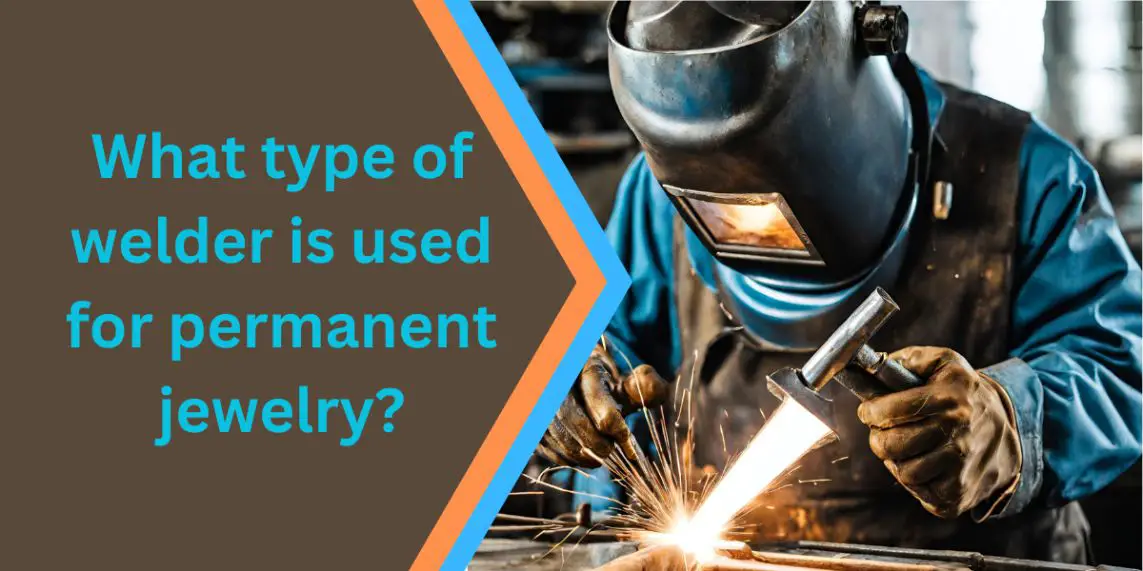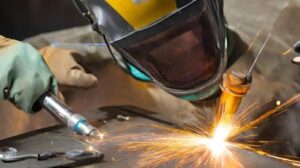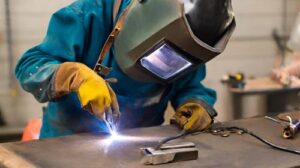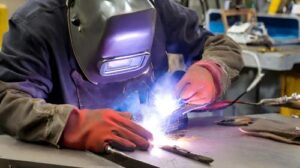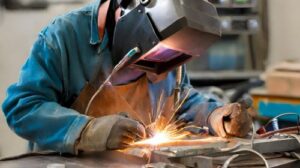Table of Contents
- 1. How Permanent Jewelry Welding Works
- 2. Types of Welders for Permanent Jewelry
- 3. Comparison of Welder Types
- 4. Considerations in Choosing a Welder for Jewelry
- Material Compatibility
- Precision Requirements
- Cost Considerations
- Ease of Use and Learning Curve
- Maintenance and Durability
- 5. Applications and Techniques in Jewelry Welding
- Detailing the Welding Process
- Specific Applications in Jewelry Making
- Techniques for Precision and Aesthetics
- Combination of Welding and Traditional Techniques
- 6. Ensuring Quality in Jewelry Welding
- 7. Industry Trends and Innovations in Jewelry Welding
- Conclusion
- Unique FAQs: about What type of welder is used for permanent jewelry?
- Are laser welders suitable for all types of metals in jewelry making?
- Can beginners use micro-TIG welders for jewelry making?
- What maintenance is required for pulse arc welders?
- How do advancements in welding technology impact the jewelry industry?
- Is welding the only method to join metals in jewelry making?
Jewelry making is an intricate craft that demands precision and permanence. When it comes to welding jewelry, the choice of welder plays a pivotal role in ensuring the durability and quality of the final piece.
Unlock the Secret What type of welder is used for permanent jewelry? Dive into the fascinating world of jewelry welding techniques and uncover the game-changing tools that are reshaping artisan craftsmanship. Don’t miss out on the innovations redefining timeless elegance.
1. How Permanent Jewelry Welding Works
In the realm of jewelry making, the concept of permanent jewelry welding embodies the essence of durability and precision. It refers to the process of seamlessly joining metals, ensuring the resulting bond withstands the test of time.
-
Definition and Significance
Permanent jewelry welding stands distinct from traditional methods like soldering or brazing due to its ability to create enduring, nearly invisible joints. This process involves the fusion of metals at a molecular level, resulting in connections that are exceptionally robust and long-lasting.
The significance of permanent jewelry welding lies in its capability to maintain the integrity of delicate jewelry pieces. It allows artisans to craft intricate designs without compromising the strength of the final product. This welding technique is particularly crucial for high-value jewelry pieces, ensuring they endure everyday wear while retaining their aesthetic allure.
Moreover, the permanence achieved through welding enhances the overall quality and value of the jewelry. It not only ensures the structural integrity of the piece but also contributes to the wearer’s confidence in the longevity of their cherished adornments.
-
Factors Influencing Choice of Welder
Several factors come into play when choosing the appropriate welder for permanent jewelry welding:
- Precision Requirements: The intricacy of the design and the level of precision needed dictate the choice of welder. For fine and detailed work, a welder offering superior precision becomes essential.
- Material Compatibility: Different metals behave differently during welding. Understanding the compatibility of the welder with the metals used in jewelry making is crucial to ensuring optimal results.
- Budget Constraints: The cost of welders varies, and while some high-end machines offer exceptional precision, they might not be feasible for all artisans. Balancing quality with affordability becomes a key consideration.
- Ease of Use: For artisans at varying skill levels, the ease of operating the welder and the learning curve associated with it are crucial factors influencing their choice.
- Durability and Maintenance: The longevity of the welder and its maintenance requirements are essential to consider for continued quality in jewelry production.
Understanding these factors aids artisans in making informed decisions, ensuring that the chosen welder aligns with the specific requirements of their jewelry-making process.
2. Types of Welders for Permanent Jewelry
In the intricate world of jewelry making, various types of welders offer unique capabilities tailored to the demands of creating enduring and delicate pieces. Understanding the nuances of these welders is crucial for artisans striving to elevate their craft.
-
Laser Welders
Laser welders stand out for their exceptional precision and minimal heat application, making them a preferred choice for intricate jewelry work. The concentrated beam of light emitted by laser welders enables artisans to target specific areas with unparalleled accuracy. This precision is particularly valuable when working on intricate designs or repairing minute imperfections in precious jewelry pieces.
However, the high cost and expertise required to operate laser welders can pose challenges, especially for smaller-scale jewelry artisans. Yet, despite the initial investment and learning curve, the precision and minimal heat impact offered by laser welders make them invaluable for certain applications in jewelry making.
-
Micro-TIG Welders
Micro-TIG welders utilize a tungsten electrode to create controlled, small welds, offering a balance between precision and usability. These welders are highly versatile and suitable for various metals used in jewelry making, including gold, silver, platinum, and their alloys.
One of the significant advantages of micro-TIG welders is their affordability relative to laser welders while still providing a considerable degree of precision. This makes them a popular choice among both established artisans and beginners looking to achieve precise welds without the complexity of high-end equipment.
-
Pulse Arc Welders
Pulse arc welders employ a pulsating electrical arc to weld metals, offering versatility in welding different materials and thicknesses. They provide a more accessible learning curve than laser welders and can handle a broader range of materials, making them suitable for diverse jewelry-making needs.
However, achieving precision in intricate designs with pulse arc welders might require a higher level of expertise. Additionally, while they offer versatility, they might not match the pinpoint accuracy of laser welders in certain delicate applications.
Understanding the capabilities and limitations of each type of welder empowers jewelry artisans to make informed decisions based on the specific requirements of their designs, materials, and skill levels.
3. Comparison of Welder Types
When considering welders for jewelry making, each type presents unique advantages and limitations. A comprehensive understanding of these aspects helps artisans choose the most suitable equipment for their specific needs.
Pros and Cons of Laser Welders
Pros:
- Precision: Laser welders offer unparalleled precision, enabling artisans to work on intricate designs with pinpoint accuracy.
- Minimal Heat Impact: The focused beam of light results in minimal heat transfer, reducing the risk of damaging delicate materials.
- Versatility: Suitable for various metals, allowing for versatile applications in jewelry making.
Cons:
- Costly Investment: Laser welders often come with a significant initial investment, making them less accessible to smaller-scale artisans.
- Expertise Required: Operating laser welders demands specialized training and expertise, adding to the overall cost and learning curve.
Pros and Cons of Micro-TIG Welders
Pros:
- Affordability: Micro-TIG welders offer a balance between precision and affordability, making them accessible to a broader range of artisans.
- Versatility: Suitable for multiple types of metals used in jewelry making, providing flexibility in designs.
- Usability: They have an easier learning curve compared to laser welders, making them suitable for artisans at various skill levels.
Cons:
- Precision Limitations: While precise, micro-TIG welders might not achieve the same level of pinpoint accuracy as laser welders in intricate designs.
- Equipment Size: Some models might have bulkier equipment, limiting maneuverability in intricate projects.
Pros and Cons of Pulse Arc Welders
Pros:
- Versatility in Materials: Pulse arc welders handle a broader range of materials and thicknesses, offering versatility in jewelry-making applications.
- Accessibility: They often have a lower learning curve compared to laser welders, making them more accessible to artisans.
Cons:
- Precision Challenges: Achieving precision in intricate designs might require a higher level of skill and expertise.
- Limitations in Delicate Work: Pulse arc welders might not match the pinpoint precision of laser welders for highly intricate jewelry pieces.
Considerations in Choosing a Welder
When selecting a welder for jewelry making, considerations extend beyond the pros and cons. Understanding the specific requirements of the project, including material compatibility, precision needs, and budget constraints, is crucial. Each welder type offers a distinct set of benefits, and the optimal choice depends on the artisan’s unique needs and expertise level.
4. Considerations in Choosing a Welder for Jewelry
Selecting the right welder for jewelry making involves a thoughtful assessment of various factors, ensuring that the chosen equipment aligns with the specific needs of the artisan and the project at hand.
Material Compatibility
Different welders exhibit varying performances with distinct metals and alloys. Understanding the compatibility of the welder with the materials commonly used in jewelry making is critical. Whether it’s gold, silver, platinum, or their alloys, ensuring that the chosen welder can work seamlessly with these materials is paramount for achieving optimal results.
Precision Requirements
The level of precision needed for the jewelry piece dictates the choice of welder. For highly intricate designs or repairs demanding pinpoint accuracy, a welder capable of delivering exceptional precision becomes essential. Assessing the welder’s capabilities in handling minute details without compromising strength is crucial in meeting the project’s precision requirements.
Cost Considerations
The cost of welders varies significantly based on their features and capabilities. While high-end laser welders offer unparalleled precision, they might pose financial challenges for artisans with limited budgets. On the other hand, micro-TIG or pulse arc welders, while more affordable, might have limitations in precision or certain applications. Balancing the quality and features of the welder with budget constraints is crucial in making an informed decision.
Ease of Use and Learning Curve
For artisans at different skill levels, the ease of operating the welder and the learning curve associated with it play vital roles. Some welders might require extensive training and expertise to operate effectively, while others offer more accessible learning curves. Assessing the level of expertise required and the time investment needed to master the equipment aids in selecting a welder that aligns with the artisan’s skills and proficiency.
Maintenance and Durability
The longevity and maintenance requirements of the welder are essential considerations for sustainable jewelry production. Ensuring that the chosen equipment is durable, requires manageable maintenance, and has available support and servicing options is crucial for continued quality in jewelry making. Regular upkeep of the welder ensures consistent performance, minimizing disruptions in production due to equipment issues.
By carefully evaluating these considerations, artisans can make informed decisions, selecting the welder that best suits their specific requirements, skill level, and budget, thereby enhancing the quality and finesse of their jewelry creations.
5. Applications and Techniques in Jewelry Welding
The art of jewelry welding encompasses various applications and techniques that empower artisans to create intricate, durable, and visually stunning pieces. Understanding these applications and techniques is crucial for artisans to master the craft and bring their creative visions to life.
Detailing the Welding Process
-
Spot Welding
Spot welding involves creating small welds at specific points, often used for joining smaller components in jewelry making. It requires precision and control to ensure strong yet discreet connections.
-
Seam Welding
Seam welding entails joining two edges of metal along their length, creating a seamless and robust bond. It’s commonly used in creating bands or rings, providing strength without compromising aesthetics.
-
Filigree Welding
Filigree welding involves delicately adding intricate designs and details to jewelry pieces through welding. This technique demands exceptional precision and control, allowing artisans to create ornate and captivating designs.
Specific Applications in Jewelry Making
-
Repair Work
Welding plays a crucial role in repairing damaged jewelry pieces, allowing artisans to restore intricate details and structural integrity.
-
Custom Designs
Welding enables artisans to bring custom designs to life, offering limitless possibilities for unique and personalized jewelry pieces.
-
Artistic Embellishments:
Welding allows for the addition of embellishments and decorative elements, enhancing the visual appeal of jewelry pieces.
-
Structural Reinforcement:
Incorporating welding techniques strengthens the structural integrity of jewelry, ensuring durability and longevity.
Techniques for Precision and Aesthetics
-
Controlled Heat Application
Mastering the control of heat during welding is essential for preserving delicate metals and achieving precise joints without compromising their strength.
-
Fine Detailing
Artisans employ specialized tools and techniques to create fine, intricate details through welding, adding visual allure to the jewelry.
Combination of Welding and Traditional Techniques
Innovative artisans blend welding with traditional jewelry-making techniques to create unique and sophisticated pieces that merge modernity with heritage.
By mastering these applications and techniques, artisans can expand their creative horizons, infuse uniqueness into their designs, and produce jewelry pieces that stand out for their durability, finesse, and aesthetic appeal.
6. Ensuring Quality in Jewelry Welding
Quality in jewelry welding extends beyond the choice of the welder itself. It encompasses a fusion of expertise, precision, maintenance, and attention to detail that collectively contribute to the durability and finesse of the final jewelry piece.
Importance of Skill and Expertise
Skilled artisans bring invaluable expertise to jewelry welding. Their knowledge of different welder types, materials, and techniques allows for precise execution, ensuring that the welds are strong, discreet, and structurally sound. The mastery of welding skills directly impacts the quality and longevity of the jewelry piece.
Precision in Execution
Precision is fundamental in welding jewelry. Artisans meticulously plan and execute welds, ensuring that each joint is flawless, contributing to both the aesthetics and durability of the piece. The ability to control heat and manipulate metals with precision is crucial to achieving the desired results without compromising the integrity of the materials.
Maintenance and Care for Welders
Regular maintenance and care for the welder equipment are essential to sustaining quality output. Cleaning, calibration, and servicing ensure that the equipment operates at its optimal capacity, maintaining consistency and quality in the welds produced. Adhering to recommended maintenance schedules minimizes disruptions in production and upholds the standard of craftsmanship.
Continuous Improvement and Training
Artisans continually refine their skills through training and exploration of new techniques and technologies. Staying updated with advancements in welding methods and equipment allows artisans to enhance their craftsmanship, producing jewelry of superior quality and innovation.
Commitment to Quality Standards
Upholding stringent quality standards throughout the welding process is crucial. From material selection to weld execution and finishing, artisans prioritize quality at every stage, ensuring that the final jewelry piece meets or exceeds industry benchmarks for durability, aesthetics, and craftsmanship.
Artisanal Passion and Dedication
Above all, the passion and dedication of artisans to their craft significantly influence the quality of jewelry welding. The commitment to excellence, attention to detail, and desire to create pieces of exceptional beauty and durability drive artisans to continuously strive for perfection in their work.
By encompassing these elements, artisans uphold the highest standards of quality in jewelry welding, resulting in pieces that not only dazzle with their aesthetics but also endure as timeless works of art.
7. Industry Trends and Innovations in Jewelry Welding
The field of jewelry welding is continually evolving, propelled by technological advancements and innovative approaches. These trends and innovations shape the landscape of jewelry making, introducing new possibilities and enhancing the capabilities of artisans.
Advancements in Welding Technology
-
Enhanced Precision Tools
Technological advancements have led to the development of welding tools with heightened precision capabilities. These tools offer artisans greater control and accuracy, allowing for the creation of intricate designs with the utmost finesse.
-
Automation and Robotics
Integration of automation and robotics in welding processes streamlines production, improving efficiency and consistency. Automated systems aid artisans in achieving precise welds while reducing manual labor and enhancing productivity.
-
3D Printing in Welding
The emergence of 3D printing technology has revolutionized jewelry making. It enables artisans to create intricate components that can be seamlessly integrated using welding techniques, expanding design possibilities and customization.
Material Innovations
-
Alloys and Composite Materials
Innovative alloys and composite materials are being developed, offering unique properties that enhance the aesthetic appeal and durability of jewelry. Welding techniques adapted to these new materials open avenues for creativity in design and functionality.
-
Sustainable Materials
There is a growing trend towards using sustainable materials in jewelry making. Welding technologies adapted to these materials ensure artisans can create eco-friendly pieces without compromising quality or design.
Future Prospects and Emerging Trends
-
Integration of AI and Machine Learning
The integration of AI and machine learning technologies in welding equipment is an upcoming trend. These advancements aid in predictive maintenance, process optimization, and even assist artisans in achieving higher precision in their work.
-
Customization and Personalization
The demand for customized and personalized jewelry continues to rise. Innovations in welding techniques and technology allow artisans to cater to this demand by offering unique, one-of-a-kind pieces tailored to individual preferences.
-
Environmental Sustainability
With a growing emphasis on sustainability, there’s a shift towards environmentally friendly practices in jewelry welding. Techniques and materials that reduce waste and energy consumption are gaining traction within the industry.
Implications for Artisans
Understanding and embracing these industry trends and innovations empowers artisans to stay at the forefront of the field. Adapting to new technologies, materials, and techniques enables artisans to explore creative avenues, enhance their craftsmanship, and meet the evolving demands of consumers in the ever-changing landscape of jewelry making.
Implications for Artisans (continued)
-
Collaboration and Interdisciplinary Approach
Industry trends encourage collaboration between jewelers, engineers, and technologists. Cross-disciplinary collaborations foster innovation by combining traditional craftsmanship with cutting-edge technology for groundbreaking advancements in jewelry welding.
-
Education and Skill Development
Artisans benefit from continuous education and skill development programs that keep them abreast of emerging trends. Training in new welding technologies and materials empowers artisans to adapt, innovate, and refine their craft.
-
Market Expansion and Diversification
Adopting new welding techniques and materials enables artisans to expand their market reach and cater to diverse consumer preferences. From bespoke artisanal pieces to contemporary designs, versatility in welding practices broadens the scope of offerings.
Future Outlook in Jewelry Welding
The future of jewelry welding holds immense promise, driven by a convergence of technological innovation, sustainable practices, and artisanal expertise. As the industry continues to evolve, artisans embracing these trends stand poised to redefine the landscape of jewelry making.
-
Precision and Customization
Advancements in welding technologies will focus on enhancing precision and customization capabilities. Artisans will leverage these advancements to create intricate designs with unparalleled accuracy and tailor pieces to individual preferences.
-
Sustainable Practices
Environmental consciousness will increasingly influence welding practices. Artisans will explore sustainable materials and adopt eco-friendly welding techniques to align with consumers’ growing emphasis on ethical and sustainable jewelry.
-
Integration of Advanced Technologies
Further integration of advanced technologies like AI, augmented reality (AR), and additive manufacturing (3D printing) will revolutionize the jewelry welding landscape. These technologies will offer new possibilities for design, production efficiency, and quality control.
Conclusion
In conclusion, the quest for the perfect welder in jewelry making unveils a world where precision meets artistry. The nuances of laser welders, micro-TIG welders, and pulse arc welders offer a glimpse into the tools shaping timeless creations. From intricate designs to durability, the choice of welder impacts the essence of permanent jewelry. Exploring this realm illuminates the path to crafting enduring pieces that blend precision, finesse, and the artistry of welding techniques.
Unique FAQs: about What type of welder is used for permanent jewelry?
Are laser welders suitable for all types of metals in jewelry making?
Laser welders work well with a variety of metals like gold, silver, and platinum, but they might require adjustments for some alloys.
Can beginners use micro-TIG welders for jewelry making?
Micro-TIG welders offer a balance of precision and usability, making them suitable for beginners after adequate training.
What maintenance is required for pulse arc welders?
Regular cleaning and upkeep of the electrode and machine parts are crucial for the optimal performance of pulse arc welders.
How do advancements in welding technology impact the jewelry industry?
Technological advancements introduce faster, more precise welding techniques, enabling intricate designs and efficiency in jewelry production.
Is welding the only method to join metals in jewelry making?
No, other methods like soldering and brazing also join metals in jewelry making, but welding offers exceptional strength and permanence.
